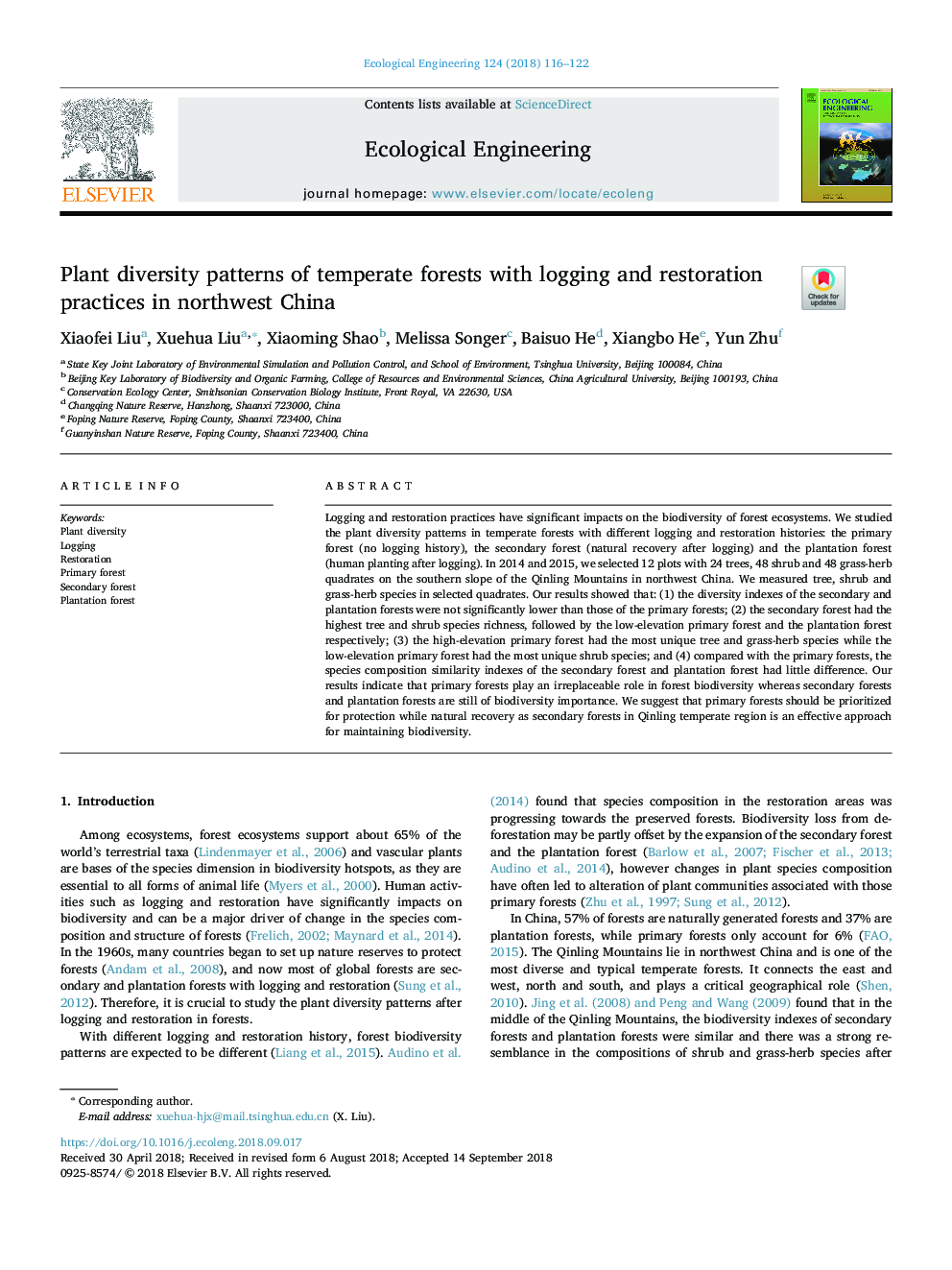| کد مقاله | کد نشریه | سال انتشار | مقاله انگلیسی | نسخه تمام متن |
|---|---|---|---|---|
| 11025207 | 1701024 | 2018 | 7 صفحه PDF | دانلود رایگان |
عنوان انگلیسی مقاله ISI
Plant diversity patterns of temperate forests with logging and restoration practices in northwest China
ترجمه فارسی عنوان
الگوهای تنوع گیاهان جنگل های معتدل با عملیات چوبکاری و ترمیم در شمال غربی چین
دانلود مقاله + سفارش ترجمه
دانلود مقاله ISI انگلیسی
رایگان برای ایرانیان
کلمات کلیدی
تنوع گیاهی، ثبت نام ترمیم، جنگل اولیه، جنگل ثانویه، جنگل های گیاهی
ترجمه چکیده
اقدامات ورود و بازسازی تاثیرات قابل توجهی بر تنوع زیستی اکوسیستم های جنگل دارند. ما الگوهای تنوع گیاهان در جنگل های معتدل با تاریخ های مختلف جنگل زدایی و ترمیم را مورد بررسی قرار دادیم: جنگل های اولیه (بدون تاریخ ورود به سیستم)، جنگل های ثانویه (بهبود طبیعی پس از جنگل) و جنگل های کاشته شده (کاشت انسان پس از جنگل). در سال های 2014 و 2015، 12 قطعه را با 24 درخت، 48 درختچه و 48 قطعه علف گیاهی در شیب جنوبی کوه های چینگل در شمال غربی چین انتخاب کردیم. ما درختان، درختچه ها و گیاهان علفی در اندازه های انتخاب شده اندازه گیری شده اند. نتایج ما نشان داد که: (1) شاخص های تنوع جنگلی ثانویه و کاشت به طور معنی داری کمتر از جنگل های اولیه نیستند؛ (2) جنگل ثانویه دارای بیشترین غنای گونه ای درخت و درختچه بود که به ترتیب به ترتیب جنگل های کم ارتفاع و جنگل های گیاهی بودند. (3) جنگل های اولیه ارتفاع بالا دارای گونه های منحصر به فرد درختان و گیاهان علفی بودند در حالی که جنگل های اولیه کم ارتفاع دارای گونه های منحصر به فردی از درختچه بودند؛ و (4) در مقایسه با جنگل های اولیه، شاخص های تشابه ترکیب گونه های جنگلی ثانویه و جنگل های کاشت دارای تفاوت اندکی بودند. نتایج ما نشان می دهد که جنگل های اولیه نقش مهمی در تنوع زیستی جنگل ایفا می کنند، در حالی که جنگل های جنگلی و جنگل های گیاهی هنوز از اهمیت تنوع زیستی برخوردار نیستند. ما پیشنهاد می کنیم که جنگل های اولیه برای حفاظت اولویت بندی شوند، در حالی که بازیابی طبیعی به عنوان جنگل های ثانویه در منطقه معتدل چینیلی، یک رویکرد موثر برای حفظ تنوع زیستی است.
موضوعات مرتبط
علوم زیستی و بیوفناوری
علوم کشاورزی و بیولوژیک
بوم شناسی، تکامل، رفتار و سامانه شناسی
چکیده انگلیسی
Logging and restoration practices have significant impacts on the biodiversity of forest ecosystems. We studied the plant diversity patterns in temperate forests with different logging and restoration histories: the primary forest (no logging history), the secondary forest (natural recovery after logging) and the plantation forest (human planting after logging). In 2014 and 2015, we selected 12 plots with 24 trees, 48 shrub and 48 grass-herb quadrates on the southern slope of the Qinling Mountains in northwest China. We measured tree, shrub and grass-herb species in selected quadrates. Our results showed that: (1) the diversity indexes of the secondary and plantation forests were not significantly lower than those of the primary forests; (2) the secondary forest had the highest tree and shrub species richness, followed by the low-elevation primary forest and the plantation forest respectively; (3) the high-elevation primary forest had the most unique tree and grass-herb species while the low-elevation primary forest had the most unique shrub species; and (4) compared with the primary forests, the species composition similarity indexes of the secondary forest and plantation forest had little difference. Our results indicate that primary forests play an irreplaceable role in forest biodiversity whereas secondary forests and plantation forests are still of biodiversity importance. We suggest that primary forests should be prioritized for protection while natural recovery as secondary forests in Qinling temperate region is an effective approach for maintaining biodiversity.
ناشر
Database: Elsevier - ScienceDirect (ساینس دایرکت)
Journal: Ecological Engineering - Volume 124, 1 December 2018, Pages 116-122
Journal: Ecological Engineering - Volume 124, 1 December 2018, Pages 116-122
نویسندگان
Xiaofei Liu, Xuehua Liu, Xiaoming Shao, Melissa Songer, Baisuo He, Xiangbo He, Yun Zhu,
